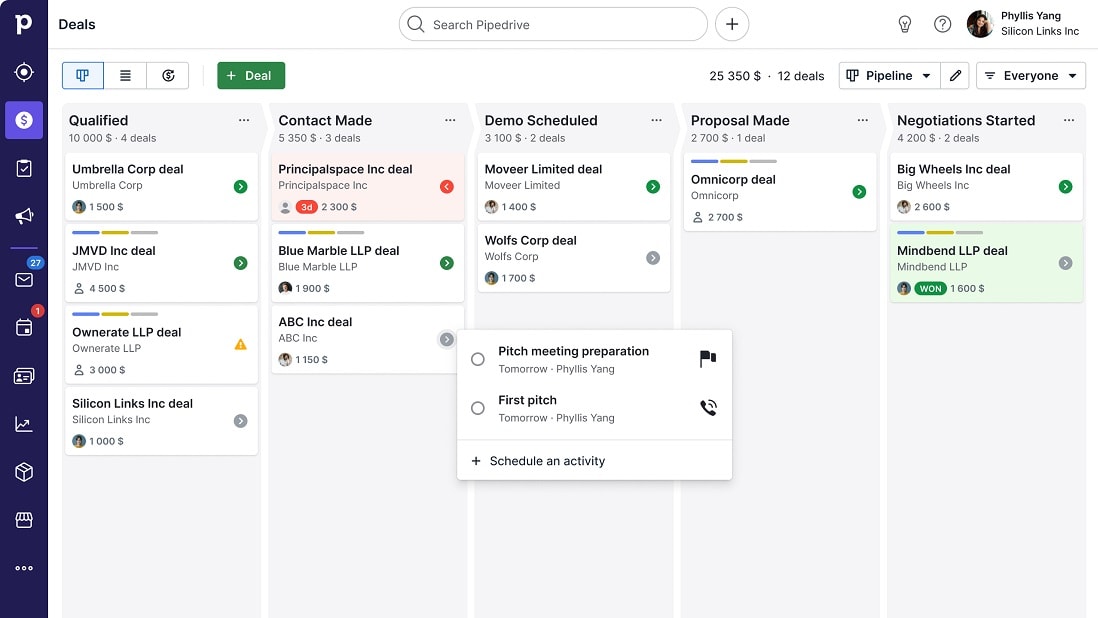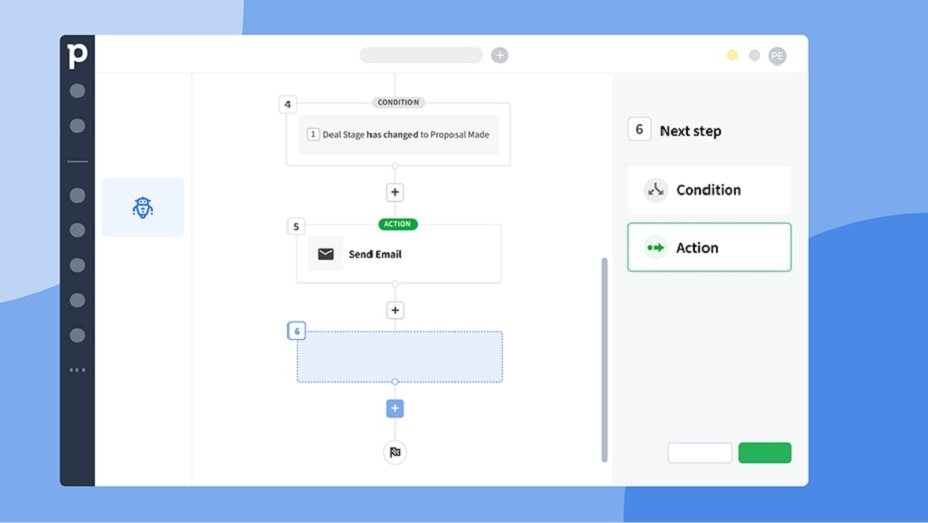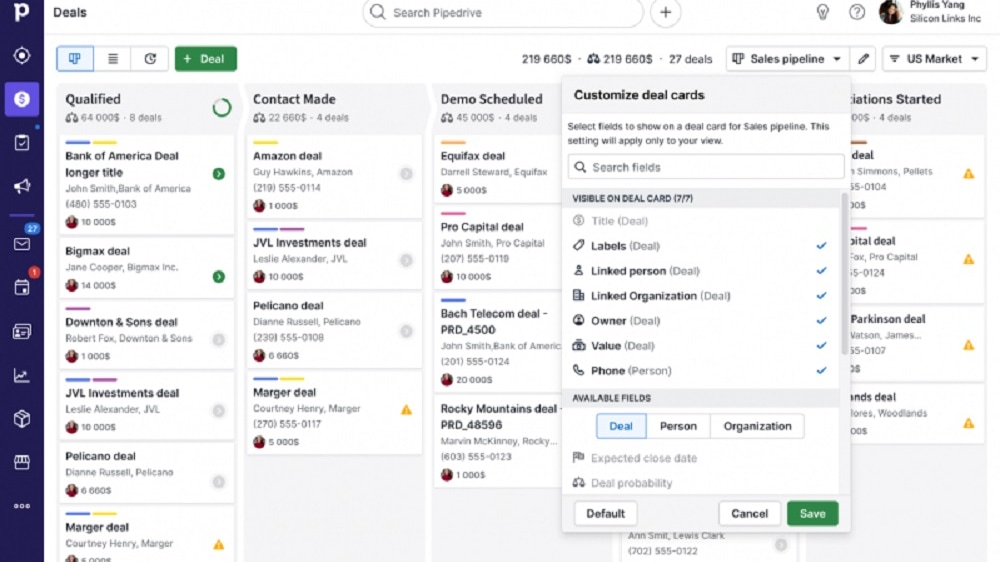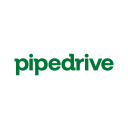Pipedrive vs Close.io compared: Which is the best for me?
- 01Pipedrive vs Close: overview
- 02What's the difference between Pipedrive and Close?
- 03Pipedrive pros and cons
- 04Close pros and cons
- 05Pipedrive compared to Close
- 06Close compared to Pipedrive
- 07Features comparison
- 08Pipedrive vs Close: Which is the best for your business?
- 09Promotions on Prospecting software
- 10Alternatives to Pipedrive & Close
Save up to $4,644 on Pipedrive
Pipedrive
30% off for 12 months
Save up to $4,644 on Pipedrive
Pipedrive
30% off for 12 months
Navigating through the realm of sales management requires a keen sense of organization and an unwavering commitment to conversions. As sales professionals, we are always worried about the challenges of ensuring no potential sale falls through the cracks. If you've faced the intricate dance of leads and deals, you're not alone. Many sales professionals, including myself, encounter this delicate balancing act daily. Therefore, finding the right tool to guide us is pivotal.
In our quest for an effective sales management tool, two notable contenders step into the spotlight: Pipedrive and Close. Both the platforms are each armed with a unique set of features aimed at simplifying sales processes and enhancing efficiency. In this post today, we embark on a journey to dissect the strengths and nuances of these platforms. Our aim is to gather all the insights necessary so that we can make an informed choice for our sales ventures. So, let us explore which is the best tool to optimize our sales management - Pipedrive or Close?
Pipedrive vs Close: overview
In the realm of sales and customer relationship management, two prominent contenders, Pipedrive and Close, stand out, each bringing unique strengths tailored to diverse business requirements.
Pipedrive is renowned for its intuitive and user-friendly interface, streamlining the sales process with visual pipelines and easy-to-use deal tracking. It offers an efficient solution for businesses aiming to manage leads and deals seamlessly. On the other hand, Close shines with its emphasis on communication and automation. This platform empowers sales teams with powerful calling features, enabling them to make and log calls directly within the system.
Now, let's delve into the comparison of Pipedrive vs Close, dissecting their key features and functionalities to guide you in making a well-informed decision when selecting the optimal sales and communication platform for your growing enterprise.
What's the difference between Pipedrive and Close?


When delving into a comparison of the two robust CRM tools, Pipedrive and Close, it becomes evident that two key factors stand out as significant differentiators: customization capabilities and sales reporting and analytics functionalities. Pipedrive distinguishes itself particularly in the realm of customization, providing users with the exceptional ability to tailor their sales processes according to their unique workflows and business requirements. This tool enables the creation of custom fields, stages, and activities, thereby granting sales teams the empowerment to align the CRM precisely to their specific needs. The flexibility Pipedrive offers allows for seamless integration across various industries and business models, rendering it a versatile choice.
Alternatively, while Close also boasts a plethora of robust sales management features, it falls slightly short in comparison to Pipedrive in terms of customization options. The degree of adaptability and fine-tuning available with Pipedrive isn't mirrored to the same extent within the Close platform.
Shifting focus to sales reporting and analytics, Pipedrive shines with its ability to deliver visually engaging and insightful sales reports. Through the platform's well-crafted visual representations, users gain clear overviews of their sales pipelines, performance metrics, and discernible key trends. These visual aids expedite decision-making processes and pinpoint areas for potential improvement, offering an advantageous analytical edge. On the other hand, Close also offers valuable analytics capabilities, yet it may not provide the same level of visual clarity and accessibility as Pipedrive's reporting system does.
Pipedrive's strength lies in its extensive customization options and visually compelling sales reporting, creating an environment well-suited for businesses seeking tailored solutions and insightful data visualization. Close, however, shines in delivering solid sales management features. The choice between these two platforms ultimately hinges on your specific sales goals and business needs, as both offerings present valuable tools for optimizing sales endeavors.
20% off for 12 months on Pipedrive
Get 20% off for 12 months on Pipedrive and up to $2,376 savings with Secret.
Pipedrive pros and cons
What are the advantages of Pipedrive?
- Intuitive interface: Pipedrive boasts a user-friendly and visually appealing interface, making it easy for sales teams to navigate and adopt without extensive training.
- Customization: The platform offers extensive customization options, allowing businesses to tailor sales pipelines, stages, and activities to match their unique processes and workflows.
- Visual sales pipeline: Pipedrive's visual representation of the sales pipeline enables teams to have a clear and real-time view of deals in progress, aiding prioritization and decision-making.
- Email integration: Seamless integration with email services allows users to track communication with leads and clients directly within the CRM, facilitating timely follow-ups.
- Mobile app: Pipedrive's mobile app ensures sales professionals stay connected and updated on-the-go, allowing them to manage leads and deals from anywhere.
What are the disadvantages of Pipedrive?
- Advanced reporting limitations: While Pipedrive offers basic sales reporting and analytics, more complex reporting needs might require third-party integrations or additional tools.
- Limited marketing features: Pipedrive's primary focus is on sales management, and it may lack comprehensive marketing automation features that some businesses require.
- Learning curve for advanced features: While the interface is intuitive, mastering advanced customization and integration features might require time and training.
- Price for additional users: Pipedrive's pricing model could become costly as your team grows, especially if you require access for multiple users.
- Integration complexity: While Pipedrive offers integrations with various apps, setting up and managing these integrations can sometimes be more complex than expected.
Compare Pipedrive to other tools
Close pros and cons
What are the advantages of Close?
- Communication-centric: Close excels in communication features, with built-in calling, email automation, and real-time activity tracking, enhancing sales team collaboration and efficiency.
- Email tracking and automation: The platform provides robust email tracking and automation capabilities, helping sales teams personalize outreach and follow-ups effectively.
- Lead management: Close's lead management tools facilitate organized lead tracking, nurturing, and segmentation, streamlining the sales process.
- Reporting and analytics: While not as visual as some competitors, Close offers comprehensive reporting and analytics tools to track sales performance and identify trends.
- Integration ecosystem: Close supports integrations with various third-party apps, enhancing its versatility and allowing businesses to connect it with other essential tools.
What are the disadvantages of Close?
- Lack of customization: Compared to some other CRM platforms, Close might have limitations in terms of customizing sales processes and pipelines to fit unique workflows.
- Learning curve for advanced features: Utilizing Close's advanced features like automation workflows and reporting might require a learning curve for optimal utilization.
- Visual reporting: While Close provides reporting features, its visual clarity might not be as strong as some competitors, potentially making data interpretation less intuitive.
- Pricing: Close's pricing structure could be seen as relatively higher compared to other CRM solutions, especially for smaller businesses.
- Limited marketing features: Close's primary focus is on sales management, which could mean that some marketing automation capabilities are less comprehensive than specialized marketing tools.
Pipedrive compared to Close
When contrasting Pipedrive and Close within the realm of sales and CRM software, Pipedrive emerges as a frontrunner due to its exceptional customization features and user-centric design. Pipedrive's hallmark lies in its ability to empower users with tailored sales processes that align precisely with their unique workflows. With customizable fields, stages, and activities, Pipedrive enables sales teams to seamlessly adapt the platform to their distinct requirements, fostering a sense of ownership and efficiency.
While Pipedrive offers an intuitive interface that simplifies adoption, Close shines with its email tracking and automation capabilities, which facilitate personalized and timely interactions. Pipedrive's strength in customization enables businesses to finely tune their sales strategies, whereas Close's communication tools bolster engagement and responsiveness.
Is Pipedrive better than Close?
Determining whether Pipedrive surpasses Close hinges on your specific business requirements.
Pipedrive shines in its user-friendly interface, particularly beneficial for small to midsize businesses, with visually intuitive pipeline management. For instance, a startup that prioritizes streamlined lead tracking might find Pipedrive's customization and ease of use advantageous.
Conversely, Close's strength lies in integrated communication, featuring call and email functionalities—ideal for sales teams aiming to enhance engagement. A B2B company valuing swift communication might favor Close. Ultimately, the "better" choice depends on context; Pipedrive suits seamless management, while Close resonates with communication-driven sales teams, both catering optimally in distinct scenarios.
What is Pipedrive best used for?
Pipedrive finds its prime utility in visually orchestrating sales pipelines with its user-friendly drag-and-drop functionality. Its intuitive interface makes it an excellent fit for teams seeking seamless navigation.
A growing e-commerce business could streamline sales processes effortlessly. Beyond visual prowess, Pipedrive boasts lead scoring, email tracking, and extensive integrations – an advantageous arsenal for enhancing sales efficiency. Picture a tech startup leveraging Pipedrive's integrations to seamlessly manage leads from multiple platforms.
Thus, Pipedrive's forte lies in visually optimizing sales progression, coupled with productivity-enhancing tools, proving indispensable for businesses seeking effective sales pipeline management.
Can Pipedrive replace Close?
Opting for Pipedrive over Close for CRM and pipeline management entails considerations and potential trade-offs. If seamless communication integration and advanced reporting are vital, Close remains pertinent.
A call-centric sales team with a preference for Close's integrated calling feature might opt to retain it. However, Pipedrive could serve well for a startup with a focus on visual pipeline organization. It’s crucial to assess your team's unique requirements when contemplating a transition. Pipedrive's versatility might suffice, yet the extent to which it replaces Close relies on your team's particular necessities and the functionalities deemed indispensable for sustained efficiency.
Is Pipedrive cheaper than Close?
Comparing pricing, Pipedrive showcases greater affordability, offering tiered plans that commence at a lower entry point compared to Close. Yet, assessing value goes beyond cost alone.
Delve into plan specifics to discern comprehensive offerings. For instance, Pipedrive's Essential Plan could suit a small startup aiming to streamline sales processes, whereas Close's enhanced communication features could be indispensable for a bustling sales team requiring integrated calling and email capabilities.
While Pipedrive's pricing might appear more budget-friendly upfront, ensuring it aligns with your business needs is pivotal. The decision hinges on striking a balance between cost-effectiveness and essential functionalities.
Is there a better Prospecting software than Pipedrive?
When it comes to CRM software, Pipedrive certainly holds its ground as a robust solution for managing sales and customer relationships. However, in the realm of CRM software, there are alternatives to Pipedrive's tool that might be considered better suited to specific business needs.
For instance, Freshsales, noCRM, EngageBay and Insightly are some of the CRM platforms that offer a wide range of features similar to, and in some cases more extensive than, Pipedrive.
The choice of CRM software that's best for your business will depend on various factors such as the scale of your operations, integration requirements, budget constraints, and the particular functionalities that align with your sales and customer management strategies. Just as with any tool, selecting the right CRM software involves evaluating your unique needs to determine which option will empower your business to thrive.
30% off for 12 months on Pipedrive
Get 30% off for 12 months on Pipedrive and up to $4,644 savings with Secret.
Close compared to Pipedrive
When it comes to efficient CRM tools, a similar comparison emerges between Close and Pipedrive. Close distinguishes itself with its communication-centric approach. Close's core strength lies in streamlining communication for sales teams, providing integrated calling, email automation, and real-time activity tracking. This robust communication ecosystem empowers sales professionals to engage seamlessly and efficiently with leads and clients.
The selection between Close and Pipedrive revolves around distinct sales and CRM objectives. Close's emphasis on communication tools and collaboration aligns well with businesses seeking to optimize engagement and interactions within their sales teams.
Is Close better than Pipedrive?
While Close shares similarities with Pipedrive, its strengths, such as advanced call analytics, built-in telephony, and seamless email integrations, position it as potentially superior.
Consider a high-volume sales team that heavily relies on call analytics and in-platform communication; Close could amplify efficiency. However, the notion of "better" remains tailored to individual business dynamics. For a startup emphasizing streamlined pipeline management, Pipedrive's customizable stages might hold greater appeal.
Ultimately, the determination of superiority hinges on aligning CRM capabilities with your business's specific goals and operational prerequisites.
What is Close best used for?
Close excels in domains where sales communication takes center stage. Its standout feature is the integration of email and telephony right within the CRM. Imagine a real estate agency, where agents must make numerous calls and emails daily to prospective buyers and sellers. Close seamlessly merges these activities, ensuring every conversation is tracked and logged.
Sales teams, particularly those engaged in high-volume outbound activities, can streamline their workflow. This feature-rich communication hub ensures that valuable interactions aren't scattered, empowering teams to efficiently manage conversations, enhance follow-ups, and ultimately close deals more effectively.
Can Close replace Pipedrive?
Substituting Pipedrive with Close is conceivable, especially for enterprises requiring robust communication integrations and comprehensive reporting.
Consider a software company managing a global sales team; Close's communication-centric tools could enhance remote collaboration. However, if your focus rests on streamlining lead progression and favoring an intuitive interface, Pipedrive's customizable pipelines might prove paramount. For instance, a consultancy might prioritize Pipedrive's user-friendly design to ensure leads are effectively nurtured through various stages.
Deciding to shift platforms rests on aligning software attributes with your distinct business needs – an assessment crucial for optimizing CRM efficiency.
Is Close cheaper than Pipedrive?
Comparing costs, Close's pricing might appear steeper than Pipedrive initially. Yet, delving deeper unveils the value proposition.
A call-centric sales team heavily leveraging Close's integrated calling feature could find the investment worthwhile. Similarly, an enterprise emphasizing advanced reporting and analytics could reap substantial insights from Close's offerings, justifying the higher price point.
While Pipedrive's affordability is tempting, considering the enhanced communication and analytics tools of Close can prove cost-effective in the long run, particularly for businesses requiring these specialized functionalities. It's vital to weigh the pricing differential against the specific benefits and efficiencies each platform brings to your sales operations.
Is there a better Productivity software than Close?
When it comes to CRM software, Close certainly stands as a robust solution for communication-driven sales management. However, there are alternative CRM software that might be deemed better suited to address specific business needs.
For example, Salesforce, HubSpot CRM, Zoho CRM, Microsoft Dynamics 365, and Freshsales are some of the alternative CRM platforms to Close that offer comparable or even enhanced sets of features compared to Close.
The determination of a better CRM software than Close will hinge on various factors such as the scale of your operations, integration requirements, budget considerations, and the specific capabilities that align with your sales and customer relationship strategies.
Features comparison
Pipedrive Takes the Lead with Intuitive Interface and Streamlined Design

When evaluating SaaS solutions, user-friendliness stands as a pivotal criterion. In this aspect, Pipedrive emerges as the front-runner.
The platform's intuitive interface and clear-cut design render it a user-friendly haven for both newcomers and experienced users. With well-organized widgets and easily categorized deals, tracking progress becomes effortless. Notably, Pipedrive's functionality requires no extensive technical training, allowing users to jump right in.
While Close does offer ease of use, its interface may occasionally appear cluttered and somewhat less intuitive than Pipedrive's. Thus, when considering user experience and the ease of mastering the tool, Pipedrive triumphs as the ultimate choice.
Close's Superior Prospect Prioritization Sets It Apart

In the realm of prospect prioritization, Close emerges as the victor, thanks to its holistic perspective and user-friendly filtering mechanism.
Close empowers teams to swiftly pinpoint high-priority prospects, enabling efficient resource allocation. For example, a B2B software company can swiftly identify potential enterprise clients based on predefined criteria. The tool further elevates efficiency by facilitating workflow automation tailored to target these key prospects, ensuring tailored interactions.
While Pipedrive proficiently manages prospects, it trails in advanced prioritization capabilities compared to Close. This distinction underscores Close's knack for refining outreach strategies and intensifying focus on prospects with the highest conversion potential.
Pipedrive and Close Showcase Parity in Insights and Reports

Comparing insights and reporting prowess, Pipedrive and Close stand neck and neck, offering robust capabilities that liberate users from spreadsheets.
Both tools empower users to harness interactive dashboards for data manipulation. For instance, Pipedrive might enable a sales team to craft custom CRM fields to generate unique reports tailored to specific decisions.
Close, on the other hand, empowers a team to effortlessly filter, group, and oversee results, aiding in the identification of sales trends or operational bottlenecks. These capabilities not only streamline data analysis but also facilitate prompt decision-making for optimized sales strategies.
Pipedrive's Vast Integrations Ecosystem Sets It Apart from Close

When analyzing integration potential, both Pipedrive and Close exhibit a spectrum of connection options. Yet, Pipedrive gains a subtle advantage due to its expansive marketplace, encompassing over 400 integrations.
This rich array spans marketing automation tools, customer service apps, and project management systems, enabling Pipedrive to seamlessly adapt to diverse business environments. For instance, a growing e-commerce venture can seamlessly integrate Pipedrive with e-commerce platforms, customer support systems, and email marketing tools.
Close, while adept in integration, offers a relatively narrower selection. While it remains efficient with popular marketing tools, it might be less accommodating in assimilating with multifaceted business ecosystems compared to Pipedrive. Thus, Pipedrive emerges as the frontrunner, boasting a broad and versatile integration landscape that enriches its adaptability across various industries and business models.
Pipedrive's Supreme Task Automation Triumphs Over Close

When delving into task automation, both Pipedrive and Close harness automation capabilities. However, Pipedrive stands out in its adeptness at automating a broader spectrum of repetitive administrative tasks.
Pipedrive streamlines sales teams' operations by liberating them from mundane chores like data entry and event scheduling. Imagine a real estate agency utilizing Pipedrive to automatically update lead information from contact forms and schedule property showings. In contrast, Close excels in automating SMS and email sequences, offering a focused yet more limited scope. While advantageous, it lacks the comprehensive administrative automation prowess exhibited by Pipedrive. Thus, for a comprehensive automation toolkit, Pipedrive takes the spotlight in this domain.
Close's Exceptional Team Performance Measurement Outshines Pipedrive

When gauging team performance, Close takes the lead with its robust team reporting feature. This tool delivers real-time insights encompassing metrics such as call volume, lead conversion rate, and sales goal achievement.
A subscription-based service can monitor its sales team's call volumes and associated conversions. These dynamic insights illuminate areas ripe for enhancement, facilitating targeted coaching and strategic adjustments.
While Pipedrive enables team communication tracking, its scope falls short of the comprehensive team performance metrics featured in Close. This distinction underlines Close's prowess in not only facilitating team communication but also facilitating data-driven enhancements for amplified team productivity.
Pipedrive's Unmatched Personalized Deal Pages Enhance Prospect Engagement

When it comes to personalized deal pages, Pipedrive stands unrivaled, allowing the creation of distinct pages for each prospect. These bespoke pages seamlessly share pertinent information and updates during the sales journey.
Imagine a software startup curating a personalized deal page for an enterprise client, showcasing tailored solutions and milestones. This transparency nurtures trust and fosters stronger relationships.
While Close streamlines communication via email templates, its personalized touch doesn't parallel Pipedrive's granular per-prospect customization. Pipedrive's advanced deal page functionality elevates prospect engagement and cements its reputation as the ultimate platform for forging unique and meaningful connections.
Subscribe to our newsletters.
No FOMO here. Stay up-to-date on all the latest deals and news with our monthly newsletter straight to your inbox like 122,000+ entrepreneurs (+ Get 10% off on on our Premium Membership!)
Pipedrive vs Close: Which is the best for your business?
Pipedrive is the best tool for you if:
- You prioritize a visually intuitive interface for streamlined sales pipeline management
- Customization is crucial, allowing you to tailor sales processes to your unique workflows
- You need extensive integration options to seamlessly connect with various business tools
- Task automation is a priority, helping you eliminate repetitive administrative chores efficiently
- You seek insightful sales reporting and analytics with visual clarity for data-driven decisions
Close is the best tool for you if:
- Communication is central to your sales strategy, with integrated calling and email automation
- Prioritizing prospect engagement and prioritization is key to maximizing conversion rates
- Your sales team benefits from robust team performance metrics and real-time insights
- You require comprehensive deal tracking and engagement, particularly for high-volume activities
- Personalized deal pages and granular per-prospect customization enhance relationship-building
20% off for 12 months on Pipedrive
Get 20% off for 12 months on Pipedrive and up to $2,376 savings with Secret.
Alternatives to Pipedrive & Close
Promotions on Prospecting software
Start saving on the best SaaS with Secret.
Secret has already helped tens of thousands of startups save millions on the best SaaS like Pipedrive, Close & many more. Join Secret now to buy software the smart way.












